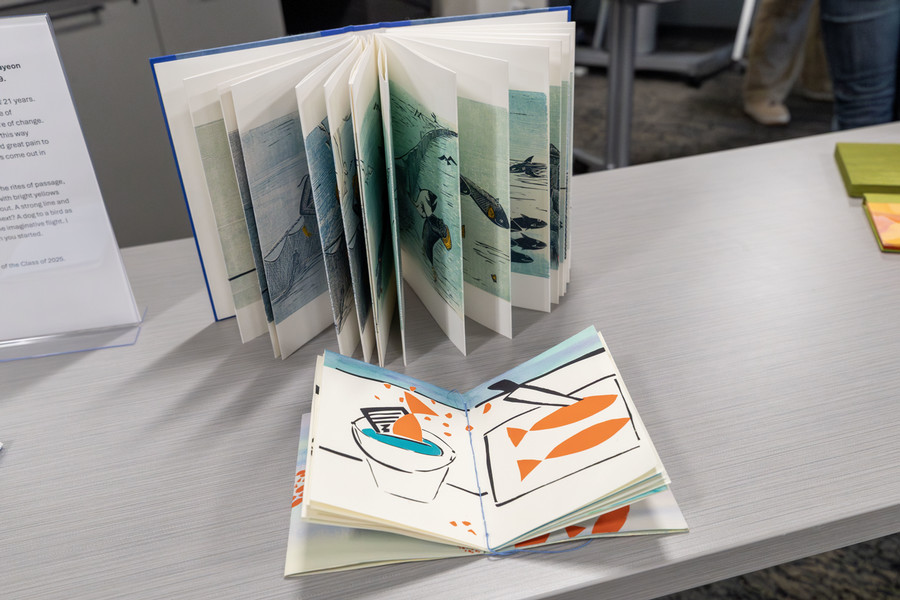Slideshow: Bowdoin’s Kolster Photographs Fossils of the Future on Hawaiian Coast
By Tom Porter
Associate Professor of Art Michael Kolster had no intention of going to Hawaii until he read an article in The New York Times back in June of 2014. “The article mentioned a report written by a geologist, a marine biologist, and a visual artist describing the discovery, on a remote beach on the big island of Hawaii, of what the report’s authors call ‘plastiglomerates,’ a new type of stone formed as melted plastic mixes with natural minerals.”
Kolster said he was fascinated by their claim that this new type of semi-synthetic material was entering the geological record and becoming a fossil of the future—a marker of the Anthropocene, as some geologists are describing the current era, during the which human activity has been the main influence on the environment.
“This is interesting,” said Kolster, “because it means these objects then become kind of a portrait of us for whoever or whatever finds them millions of years from now.” Kolster said he was also intrigued by the fact that Hawaii is often portrayed as a pristine paradise, rich in natural beauty, “but, belying this impression is that, in reality, certain stretches of its coastline are being inundated with pollution and plastic, and significantly, this trash will possibly shape the geological record.”
Why Hawaii?
To photograph these hybrids for himself, Kolster had to travel to Kamilo Beach, a remote stretch of sand on the big island of Hawaii, and, as it happens, the resting place for an inordinate amount of plastic ocean debris. “Hawaii is the most remote chain of human-occupied islands in the world,” said Kolster, “and yet, despite its remote location, a lot of trash gets washed up there.”
This, he came to learn, is due to the islands’ position in relationship to a system of rotating sea currents known as the North Pacific gyre, one of five ocean gyres in the world. “Kamilo beach is also known as ‘junk beach,’ ” he said, “because of the immense amount of trash, mostly plastic, from Japan and the US West Coast, that the gyre sends its way. There are cleanups every few months, but the deluge of detritus is hard to keep up with.”

The beach is not easy to get to, as Kolster found out for himself when he went there in March. “It’s situated miles from the nearest paved road or habitation and can only be reached after a bruising ten-kilometer journey over lava fields in a four-wheel drive vehicle,” he said, “and this is a big factor in why plastiglomerates are found on this beach.”
Kamilo, he explained, is a popular diving spot, but because of its remoteness visitors tend to camp overnight there, taking their supplies with them. “They often light fires on the beach at night; apart from anything else, this helps guide the divers back to their beach encampment when they’re swimming back to the shore.
The end result is that a lot of plastic gets burnt,” he said, “which becomes fused with the volcanic rock that’s already there.”
Artistic value
So why is Mike Kolster, a photographer, drawn to this particular subject matter, which sounds more suited to the attentions of a geologist, an oceanographer, or an environmental scientist? “The concern I have as an artist,” he explained, “is the role a photograph plays in how we see and understand the world around us. I’m especially interested in the relationships between natural and man-made forces. In this case, vast amounts of plastic on remote beaches, in what is thought of as a tropical paradise, fusing with volcanic rock due to inadvertent human action present a compelling, layered mix of these influences. I went to Kamilo in the hope of creating powerful, thought-provoking images that explore these interactions.”
Kolster said he sees a poignancy in the fact that the Hawaiian islands were formed through volcanic eruption. “They are made of lava, the newest rock on earth, and this ‘new earth’ is now coming into direct contact with plastic, one of the newest, most pervasive materials that we, ourselves, have created and that persist in our landscapes, remote or close by. I’m interested in how photography can describe the unlikely locations where man-made material can be found and the ways this material coexists, and even becomes fused with, what we label as ‘natural’”
Kolster said he’s also sensitive to the controversies around this subject, and the enormous environmental concerns it raises. “Some argue we should remove and outlaw all plastics, which, at this moment, seems impossible,” he said. “Nonetheless, it seems important to think more deeply about how plastic affects, and even endangers, the land and sea creatures that come into contact with it. Yet, how do we reconcile our reflexive repulsion to the sight of plastic on a Hawaiian beach with our dependence on these products as we conduct our daily lives? I do not know the answer, and the only way I can respond is to make photographs that beg the question.”
Stereo photography
Kolster took hundreds of stereo photographs during his ten-day stay in Hawaii. He employed two identical cameras, each affixed to a tripod and pointed at the same subject. The distance between the cameras mimics the distance between our eyes, so that when the two photographs are printed side-by-side and seen in concert, they provide a three-dimensional description of the subject. “Stereo photography was very popular earlier in the history of the medium and is still employed regularly in scientific surveys as a means to see the real world more accurately. Stereo viewing works a few different ways, depending on how the images are arranged. If the left and right eye prints stay in their respective positions, the 3-D illusion can be created with the aid of a stereo viewer, a device that helps each eye see only the image meant for it.
“Another way I particularly like to view these scenes is with the left and right views swapped. With crossed eyes,” he explained, “the viewer is able to see the scene in 3-D without the use of a device and in a more obviously interactive way. This overtly interactive mode of viewing drives home a central interest of mine: how understanding the photographic image, whether as a stereo pair or as a single image, is a learned skill, akin to reading or talking. The interpretation of a photographic description must always result from the viewer comparing previous knowledge with newly encountered perceptions. I love to underscore how, paradoxically, the photograph is both a transformation and a direct record of a specific encounter in the world.”
Slideshow: Try to view to these images in stereo by crossing your eyes, or by using a stereo-viewer









